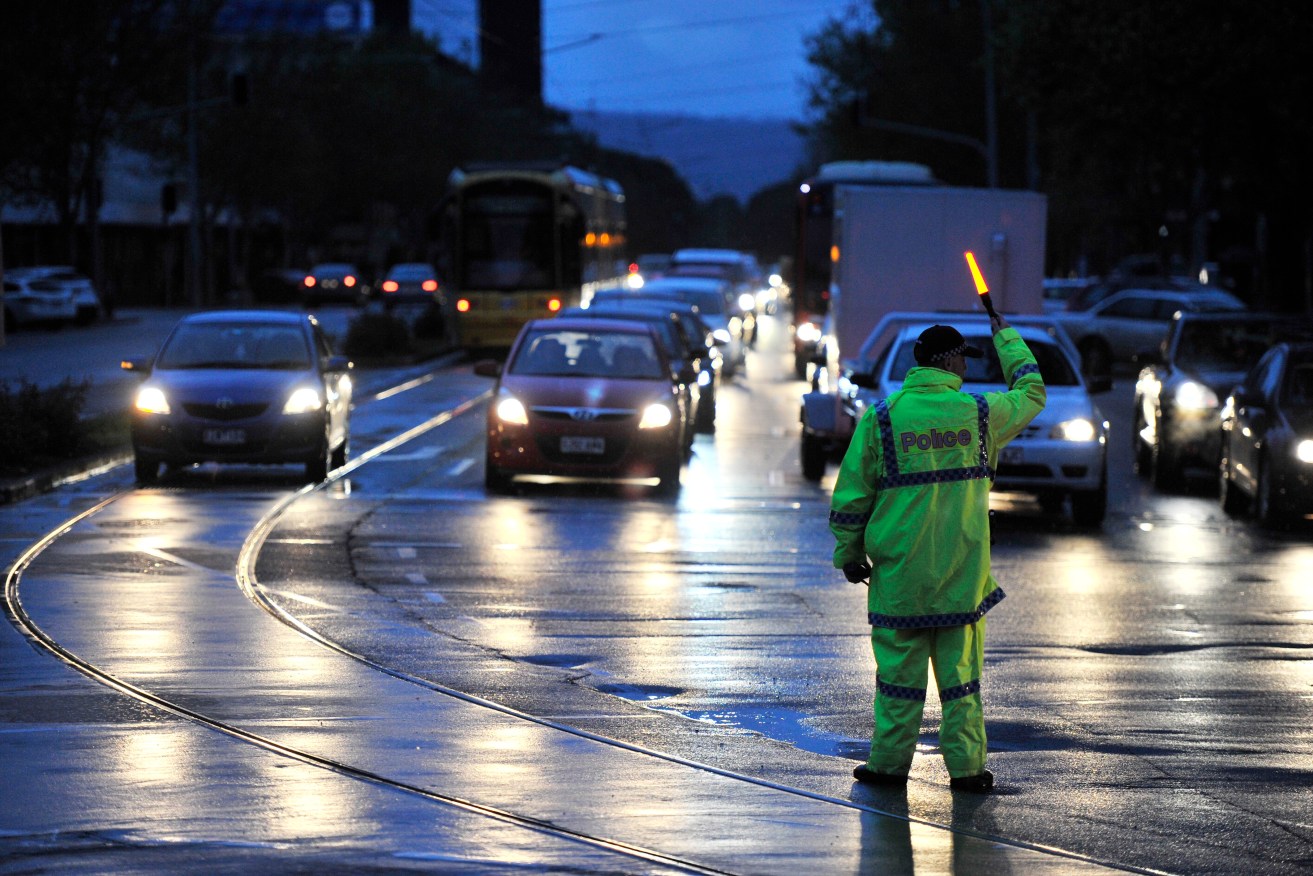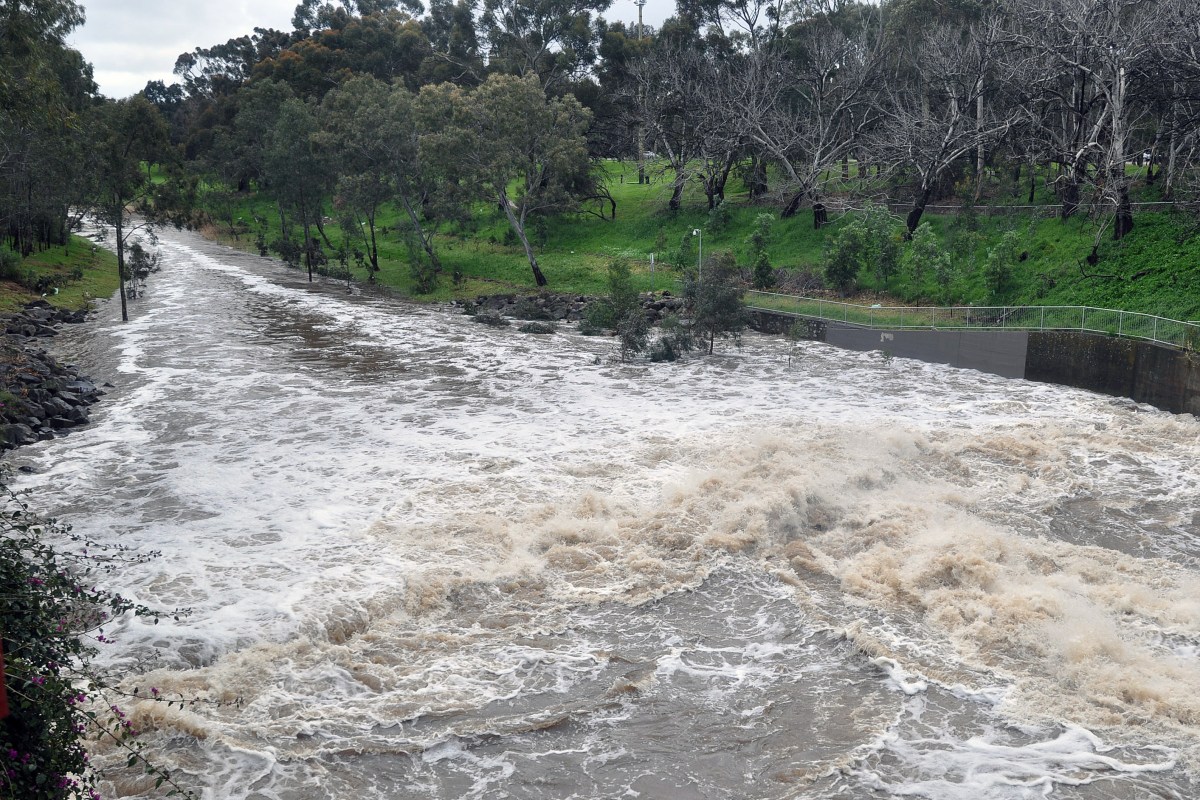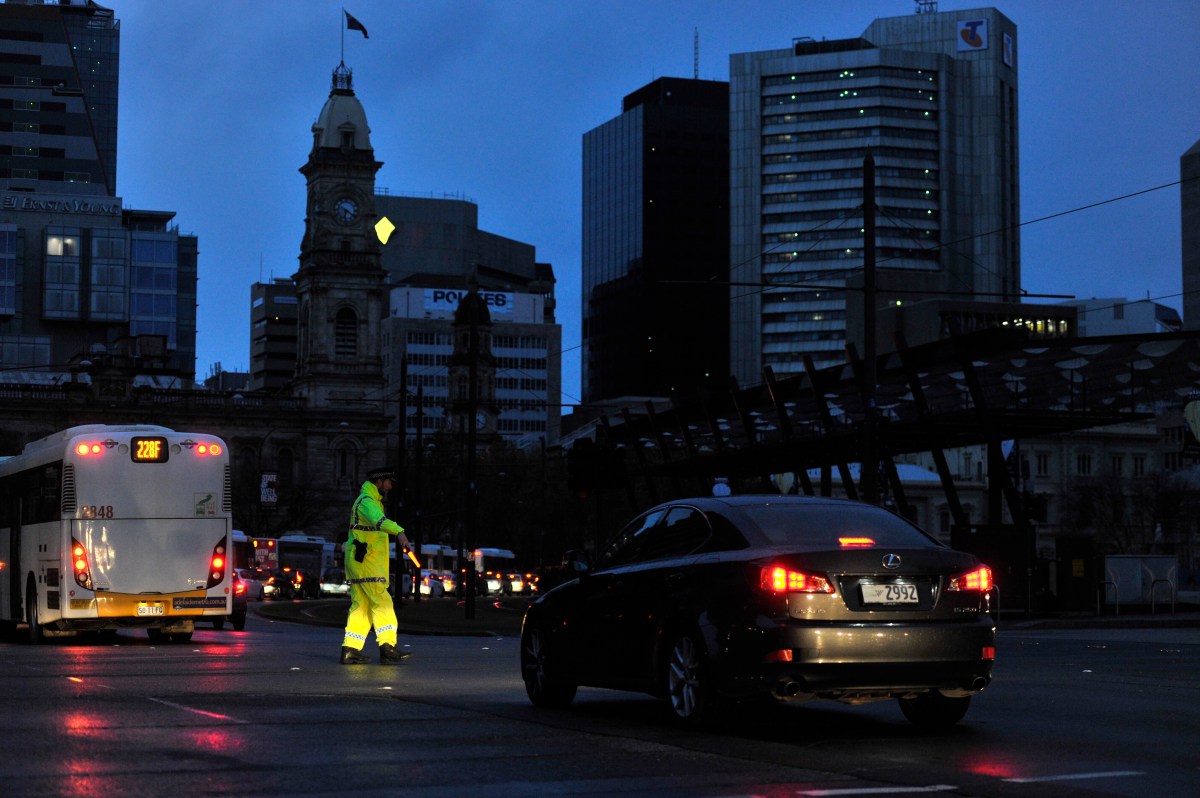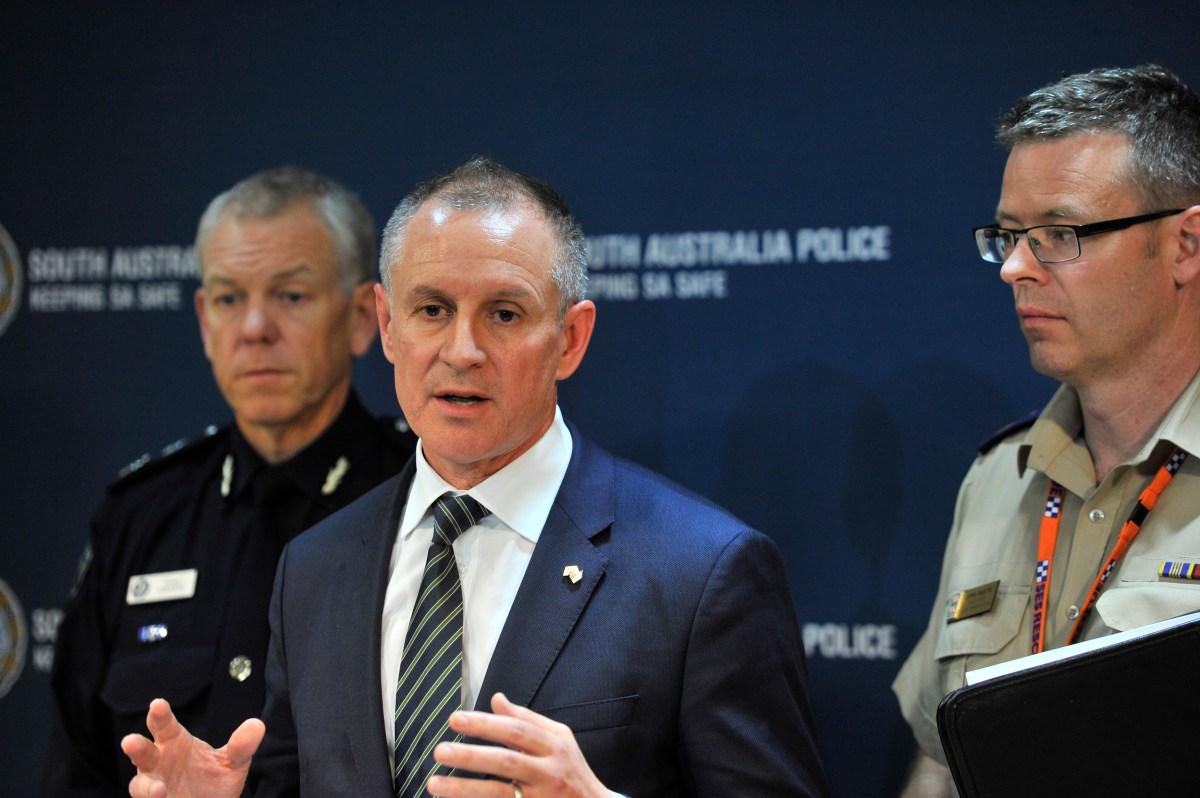Statewide blackout creates the perfect storm for Jay
UPDATED: South Australia is bracing for more severe weather as the Weatherill Government braces for a political backlash amid calls for an independent inquiry, after the entire state was yesterday plunged into extended darkness.

Police direct traffic around the CBD in Adelaide after the power network stops working. Wednesday September, 28, 2016. (AAP Image/David Mariuz) NO ARCHIVING
Premier Jay Weatherill addressed a media briefing today after spending much of the night and the morning doing the rounds on radio and television, hammering his message that the outage was the product of a “catastrophic natural event that destroyed our infrastructure”, as political accusations are again levelled against the state’s Government-led reliance on renewable energy.
“This was a weather event this was not a renewable energy event,” Weatherill insisted.
“There’s no infrastructure that can be developed to protect against catastrophic events that take out not one, not two, but several pieces of infrastructure… that potentially put at risk the whole of the National Electricity Market, the NEM disconnected to protect itself and the generators disconnected to protect themselves; if they hadn’t, we wouldn’t have had the capacity to fix this within days or hours – it would be weeks.”
Weatherill said “the system, the community and the emergency services sector has responded quickly and effectively to a massive challenge”.
But his Government will face its own challenges in the aftermath, with SA’s energy woes – underlined by an ongoing debate about spiralling costs – set to dominate parliamentary debate today.
The State Opposition has demanded an independent inquiry after Weatherill said the system worked as it was designed to, rejecting suggestions the blackout was an embarrassment or the result of SA’s high use of wind power, or indeed Alinta’s decision to shutdown coal-fired power stations in the mid north.
Authorities have blamed high winds for bringing down at least 22 transmission towers in the mid-north yesterday, with about 80,000 lightning strikes hitting the state, some damaging generation facilities.
That caused automatic emergency systems to cut power across SA to prevent damage.
“We had winds which were so strong that when they hit power lines they were creating such energy that they were tearing their towers out of the ground,” Weatherill said.
But Opposition Leader Steven Marshall told InDaily if last night’s events reflected a system doing what it’s designed to do, “it’s designed badly”.
“I don’t think it’s been designed very well, and I don’t think the people of SA think it’s been designed very well,” he said.
“It’s fundamental for a State Government to be able to provide a reliable energy source to its people.
“This Government system was put the the test yesterday and it failed; it comprehensively failed the people of SA.”
Marshall said while “we’re still not through this storm, our first concern at this stage is with people’s safety”.
However, “fairly soon we’re going to have to ask some serious questions of the Premier and Treasurer [Tom Koutsantonis] about our energy security in SA”, he said.
“Of course it was triggered by a weather event, there’s no doubt about that [but] we don’t accept the damage to power line infrastructure 250 km away should be able to bring down the entire state grid.
“This hasn’t occurred in other states with severe weather events [and] it’s a very dangerous situation.”
Marshall said the fundamental questions were not just why “the whole state plunged into darkness”, but “why did it take so long to reboot the system?”
He cited a report from last month into the SA electricity sector by the Australia Energy Market Operator, which warned that the withdrawal of the Northern Power Station has highlighted “a limited pool of strategically-located system restart ancillary services sources… to meet the current standard”.
In the meantime, the state is bracing for the wild weather to continue, with Bureau of Meteorology chief John Nairn warning the present “lull in conditions” was a temporary one.
“I’m here to tell that we will see a reintensification through the afternoon, the gales will return to all coastal waters as well as storm-force winds in the southern gulfs,” he told reporters.
“That will be a phenomena we see tracking up through the Yorke Peninsula and into the mid-north.
“My advice to the state is we’ve seen half the rain we expected to see so far through this event [so] we’re expecting quite significant falls through the latter part of the evening.”
Around 80 schools were closed around the state today, mostly associated with flood damage.
Hospitals and other emergency services across the state continued to operate using back-up generators with most able to maintain services for at least 72 hours.
However, disturbingly, back-up generators at the Flinders Medical Centre failed overnight, forcing 17 patients to be transferred to another hospital.
Some patients needed help breathing during the transfer to Flinders Private Hospital, after the back-up power failed due to a broken fuel pump – despite the system being tested earlier in the week.
Acting SA Health CEO Vickie Kaminski said the back-up generator lasted only an hour but insisted lives were not at risk.
“All of the life-saving equipment is on battery backup, and has many hours of battery backup,” she said, adding than manual respiration was also “absolutely standard in every hospital”.
All but two of the 17 patients have been returned to FMC.
But Weatherill said he would seek further answers, saying: “Of course it’s frightening when you hear that backup systems have failed.”
“Fortunately we have more than one backup system to protect health and wellbeing [but] this is a worrying development… and we will review it.”
He said health, public transport and emergency services systems had operated effectively and the national energy market operator had “sprung into action quickly”.
“Of course there will be elements that have not worked perfectly [but] I think most SA will understand this was a catastrophic weather event, it was not simply a storm,” he said.
“It’s an unprecedented weather event the likes of which the bureau of meteorology have not seen here… two tornadoes ripped through the centre of our state.
“If people understand the facts of what occurred, they will understand this is an extremely rare event.”

Floodwater surges down the River Torrens. Photo: Tim Dornin / AAP
Weatherill said he would travel to regions hardest hit by the extreme weather.
He also responded to reports of isolated looting.
“If that’s happened it’s disgusting,” he said.
“The overwhelming response of our community has been wonderful… an isolated incident is disgusting and regrettable, but doesn’t represent the overwhelming community spirit I saw in evidence.”
People in the red shaded area are supplied by damaged transmission lines – unlikely to have power tomorrow. pic.twitter.com/r5Z35IYtgt
— SA Power Networks (@SAPowerNetworks) September 28, 2016
Power was restored to much of the state overnight, albeit with around 75,000 properties – mostly in regional SA – still blacked out.
Recovery efforts are being hampered by the extreme weather, which could produce wind gusts of up to 140km/h, and up to 100 millimetres of rain across the Hills, bringing the risk of flooding.
A long night for many people & communities. Tomorrow's forecast is set to bring new challenges. Thank you everyone for patience & hard work.
— Jay Weatherill (@JayWeatherill) September 28, 2016
By late last night, power had been restored to much of the Adelaide metropolitan area and only the northern parts of the state and the Eyre Peninsula were expected to be without services into Thursday.
“We will progressively restore regional areas as more generation and transmission supply becomes available,” SA Power Networks spokesman Paul Roberts said.
Prepare for extended outages. More bad weather on its way – stay updated via @BOM_SA #sablackout https://t.co/7OanBsQwE2
— SA Power Networks (@SAPowerNetworks) September 28, 2016
“Once the metro area is supplied this will provide sufficient network stability for us to start the process of restoring supply to country areas.”

Police direct traffic around the CBD. Photo: David Mariuz / AAP
But while the state prepares for another bout of wild weather – with Weatherill pledging grants of up to $700 for those experiencing ongoing hardship – the political brinkmanship is intensifying.
Questions have got to be asked… this is the first time in my recollection that we’ve had a whole state knocked out
Prime Minister Malcolm Turnbull today blasted state Labor governments for setting “aggressive and unrealistic” renewable energy targets, arguing energy security must be a key priority for governments.
“If you are stuck in an elevator, if the lights won’t go on, if your fridge is thawing out, everything in the kitchen is thawing out because the power is gone, you are not going to be concerned about the particular source of that power,” Turnbull told reporters in Launceston.
“You want to know that the energy is secure.”
Reliance on “intermittent renewables” placed different strains and pressures on the electricity grid than traditional baseload power from fossil fuels or hydro, he said.
Turnbull said he regretted that several state Labor governments – including SA – had set “extremely aggressive, extremely unrealistic” targets for renewable energy use.
“Targeting lower emissions is very important but it must be consistent with energy security,” Turnbull said.
Federal Energy and Environment Minister Josh Frydenberg has called his state counterparts in for a meeting in the next few days to discuss what lessons should be taken from the SA outage.
“Right now in this country we have a hodgepodge of renewable energy targets that are spread differently across the state and territory and federal governments,” he told reporters in Melbourne.
The federal government’s target is to have 23.5 per cent renewable energy by 2020 but Queensland and South Australia are aiming for 50 per cent and Victoria for 40 per cent, although over longer timeframes.
But Frydenberg said those high targets had knock-on impacts, including stability of the system and skewing where investments were made, and he said he wants the states to look at agreeing on a single renewable energy target across all jurisdictions.
South Australian senator Nick Xenophon echoed the state Liberals’ calls for an inquiry into the power supply, saying the Australian Energy Market Commission should examine whether the state’s energy mix made it more vulnerable to an outage, while Deputy Prime Minister Barnaby Joyce queried whether there was an over-reliance on renewable energy.
“Questions have got to be asked,” he told ABC Radio.
“This is the first time in my recollection that we’ve had a whole state knocked out.”
Nonetheless, Frydenberg backed Weatherill’s assertion that the specific problems were caused by “a one-in-50-year weather event”.
“There was a lightning strike at a power plant, there was also transmission towers that were blown over and this led to an electricity surge across the inter connectors and as a safety valve it turns itself off in that event,” Frydenberg told ABC radio.
“The head of (the Australian Energy Market Operator) tells me that when you lose such a substantial amount of power it doesn’t matter how that power is generated, that is what will occur, the electricity grid will go down.”
He took aim at Senator Xenophon for “grandstanding … while people are stuck in their elevators or blackened out in their homes”.

Police Commissioner Grant Stevens, Premier Jay Weatherill and SA Emergency Chief Chris Beattie speak to the media last night. Photo: David Mariuz / AAP
The statewide blackout prompted police to urge people to stay off the roads with officers dispatched to direct gridlocked traffic at major intersections during Adelaide’s afternoon peak hour.
There were reports of a number of accidents, all trams and electric trains were cancelled while a number of flights in and out of Adelaide were cancelled.
Police Commissioner Grant Stevens said it was fortunate there were no reports of any deaths or injuries as a result of the blackout or the severe weather, although 19 people had to be rescued from lifts when the power failed.
The State Emergency Service responded to more than 900 calls for help on Wednesday and chief officer Chris Beattie said the wild weather would continue for at least another day.
“There’s still the potential for significant severe weather damage,” he said.
https://twitter.com/paulkidd/status/781103870114050048
The Climate Council has blamed global warming for the wild weather, with Professor Will Steffen arguing the storm is “a disturbing preview of what’s likely to come if Australia fails to act on climate change”.
He said the atmosphere is packing much more energy than 70 years ago, which contributes to the increasing intensity of storms and increased rainfall.
-with AAP




